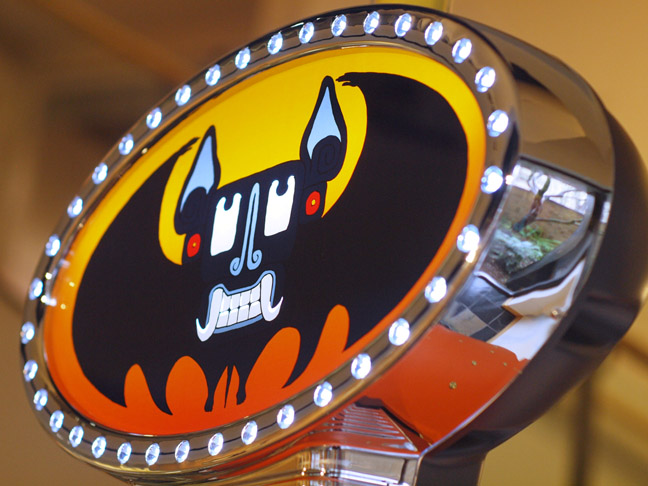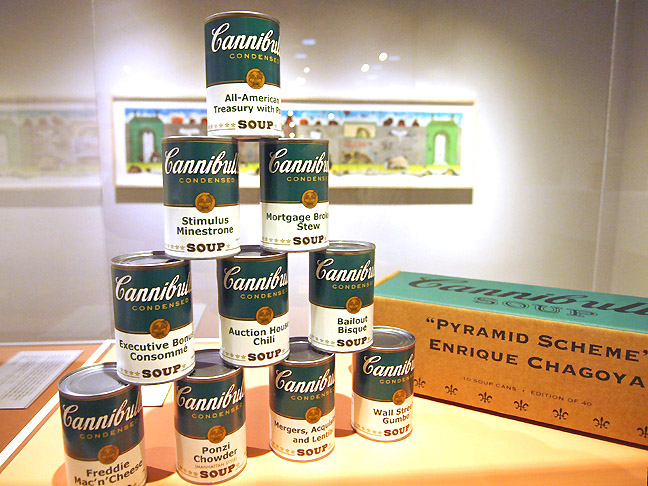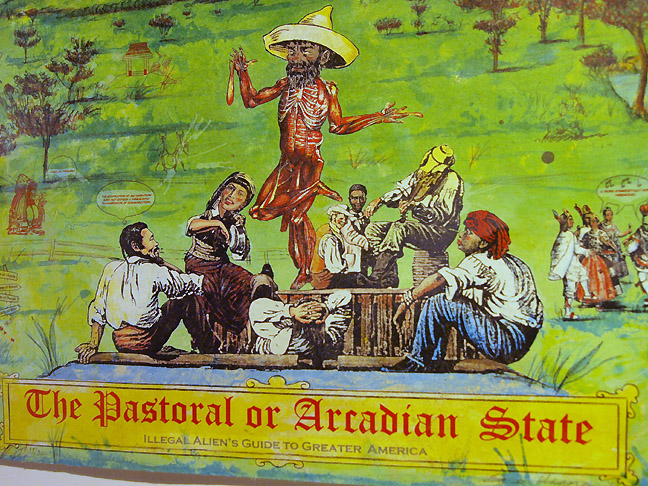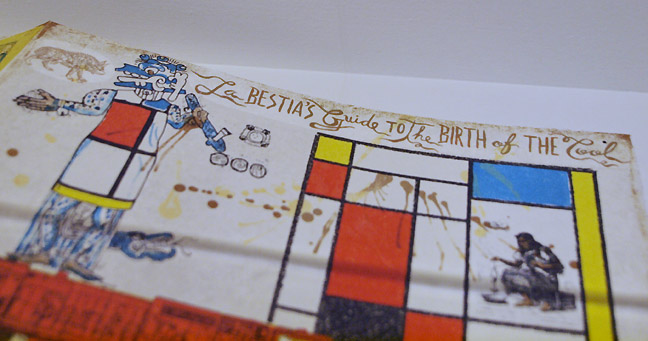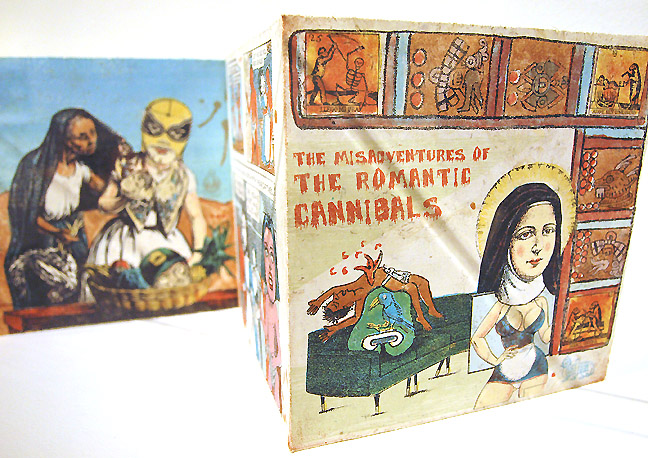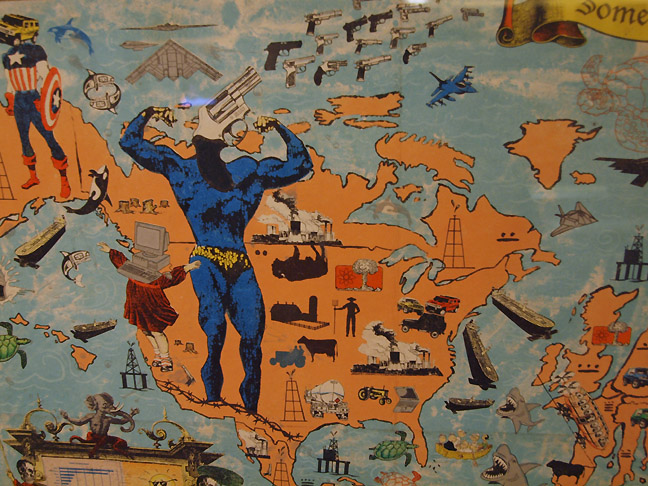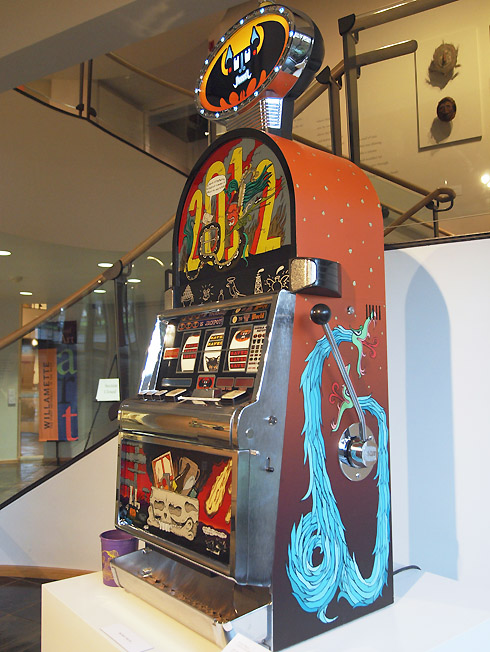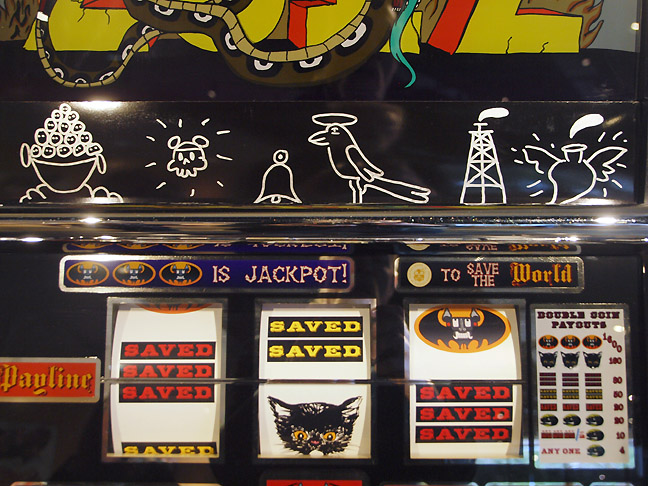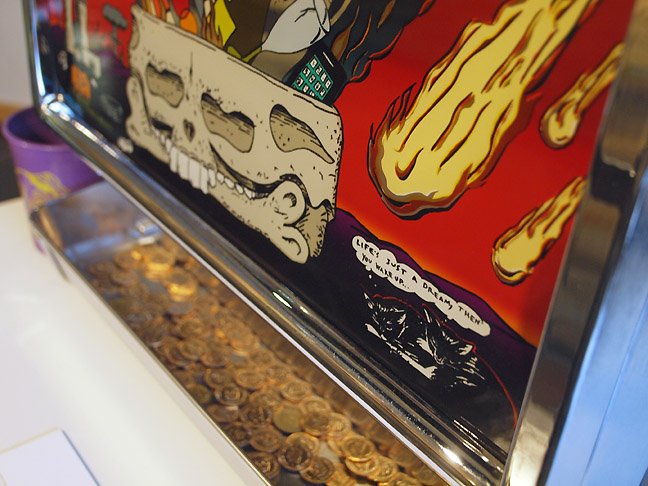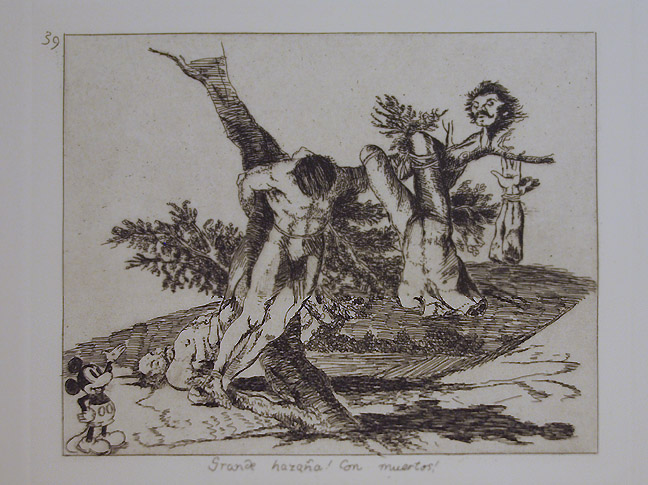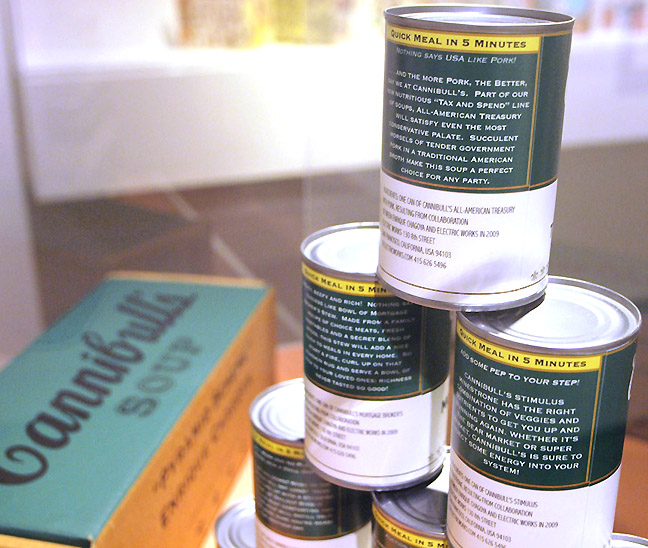
|
||
|
Portland art blog + news + exhibition reviews + galleries + contemporary northwest art
|
||
Enrique Chagoya Interview Just blocks away from Oregon's capital building, an exhibition titled Enrique Chagoya: Reverse Anthropology, From the Collections of Jordan D. Schnitzer and His Family Foundation at the Hallie Ford Museum of Art is one of the most relevant exhibitions in this incredibly loaded period of history. Through blending; economics, anthropology, race and a surprising amount of serious humor Chagoya gave PORT's Victor Maldonado an incredible one on one interview (edited for clarity, while preserving the artist to artist conversation). The exhibition is on view in Salem through January 27. V: Enrique, what are you working on in your studio? E: I am painting a codex. I've been working on some textures and some faces and I just needed to put some finishing touches on because the paint is drying. I needed to get that done for the day.
V: That is great, Enrique. Thank you so much for making time to sit down and answer some of my questions about your amazing work. I'd love it if you would just describe what you're working on just because the works I saw at the Hallie Ford Museum of Art were so vivid and exuberant. I can't imagine what they would look like in progress so would you describe what you're working on? E: I'm working on a hand painted codex. It's about 110 inches wide by about 16 inches high. This one is not a print. I have done a lot of codices as prints and I have also done a lot of one of a kind or hand-painted ones, using different techniques. This codex is about the border wall and you have stereotypical characters on both side of the border, white and people of color, people from Latin America, Asia, but everyone is a stereotype, including whites from Europe. I found stereotypical characters from everywhere. I'm painting very cake-like faces. Very fake faces, with glass eyes that I found in Mexico. These are the same glass eyes that they use for saints, some little handmade sculptures. I found a craft store that sells them, I bought a bunch of them. So I've been using them in different sizes with really thick paint, and on top of them I carefully place one of those glass eyes. And, when the paint dries it holds the eye in place I put it. Anyway, so it is hard to see it but that’s pretty much what I’m working on. V: I'm so excited to see it in real life one day. Being with your work is an experience both physically and mentally. I'm wondering what originally motivated you to start working the way you do? E: That's something that evolved over time. I began to do a lot of political cartooning in Mexico when I was studying economics and I was still not thinking that I would be making a living as an artist, though I never stopped making art. I was studying in the school of economics in Mexico City focusing on political economy. So that was very political theory and all kinds of really amazing stuff I really loved. On the side, I had a studio where I used to paint and I used to make drawings. So, I was lucky to be able to do two things but eventually, I mean it's a long story, I end up moving to this country and I wanted to keep studying economics at the school in Berkeley but it was not as exciting as in my school in Mexico for many reasons. In Mexico, I had amazing teachers from all over Latin America, even some Americans. It was a public school but it was really good. But here, even Berkeley's School of Economics, it wasn't as exciting. They were focusing on everything we criticize in Mexico. So that's when I decided to take chances and switch to art. My political views and also experiences working in the countryside, as an economist, all of that came together in my art work. So, at first I didn't think I would making a living with what I was doing. Instead of doing little, editorial cartoons, they began to be gigantic editorial cartoons. These were big pieces of charcoal, drawing on paper with charcoal and pastel. That is how my political imagery started back in the mid-eighties. Eventually, I moved into codices when the five hundred years of the arrival of Columbus was commemorated all over the world.
For the quincentenary of the encounter between Columbus and the Americas I began to make codices which are inspired by very rare Pre-Columbian books. Very few survived the fire of the conquest so currently there are only twenty-two that survived. None of them are Aztec. All of the Aztec books were burned in the Library of Texcoco in 1521. The fate was the same for the Mayan books in the south. Most of them were burned except for three, maybe four. If there is one in Mexico City that is not a fake. The other three are in Europe and they are the Codex Madrid, Codex Paris, and Codex Dresden. And, about twenty-two Mixtec Zapotecs from the Oaxaca region. So after I learned about the Pre-Columbian books, I decided to make my own codices basically inspired by the Pre-Columbian style and pictographic elements. I began to mix ancient with contemporary elements. Everything became very symbolic in the books. Suddenly, comic book characters became symbols of Colonialism, the ancient figures and elements were serving as a contrast between the different elements in the book. I haven't stopped since 1992. That’s when I first started and every year I make about two hand painted books a year and at least one printed book - one lithographic book, which are more popular because they are printed and circulate more than my hand painted books. To make the story short - that's how we started.
E: Well, living in this country, the experience of living in Mexico, but also I've lived in Europe a couple of times. Once I lived in Giverny where Monet’s gardens are in France and then I lived in Paris for almost a year. Those two times really affected the way I see the world, too. And, for me the bit-economy and that binary situation between the United States and Mexico shifted to worldwide. For me today's issues of immigration are very important between Mexico, Latin America, and the United States as we all know in the southern border. How tragic that is right now. The same situation is happening in Europe and all over the world, basically. Sometimes, between Latin American countries. I began to think, that after living in France, having the experience of living in a lot of different places, it makes me feel like I am from everywhere, and maybe from nowhere [laughs]. It made me feel that in spite our differences in languages, religions, customs, which also expand within countries in differences of social class, or gender, or cultural identity - all of that, it created a lot of difference that for me are enriching our life. Those differences are what makes life rich. But, for a minority of people that especially feel threatened by the differences, it's something they don't want to live with and all the backlash against the country changes due all these exchanges more quickly. This backlash of ultraconservative nationalist elements, like a flashback of the 1930's in Germany, but all over the world including this country. It's rather scary. So, I am addressing those issues in my current work. So, for me everybody is an immigrant. Now, when it comes to the United States basically and the Americas in general, not only the US but also the rest of the continent, illegal immigration is what created the countries everywhere. The first illegal immigrants were the Spaniards - the conquistadors. They went all the way up to the US east coast to Chesapeake Bay about fifty years before the Pilgrims arrived on Plymouth Rock. The Spaniards, later the Pilgrims, and later the waves of Europeans, those were the first illegal aliens and they created this country. And, the fact that anybody, and especially people in power, including the current administration, attacks undocumented immigration and calls them illegal aliens is like self-hate. It's the most anti-American thing I've seen living here for the almost forty years I've been living in this country. For me it's a puzzle how this anti-immigrant sentiment affects this country but it's also very sad how this country also influences other countries because the same thing is happening in Brazil now. All this new nationalist government also xenophobic government is now in Brazil. The same thing is happening in many countries in Europe and eastern Europe, and governments within the Netherlands, Germany, even in Italy. So, it's like going backwards in time. V: How do you see the codices you're painting, engaging in all of that? You talk about wanting to have space for your audience to interpret your work in different ways. But, I'm wondering if you have something specific you want your audience to walk away with when they look at your work? You're confronting them with a lot of symbols of American imperialism, of neo-colonialism - your work is a weave of advertising, propaganda, and consumerism. And, you're an educator, what lessons do you want us to learn from your work?
This was in the town of Loveland, in Colorado, at the Loveland Museum, which is a museum run by the city. Pretty soon this was on Fox News and there were people making a picket line outside. At first I thought, that's great I'll be getting a lot of good publicity here, I'm going to invite more of these fanatic people to all of my openings [laughs]. But, then it got really scary because I began to get a lot of threats, a lot of hate mail every day for weeks. Except for one pastor that understood my work and he asked me if I could explain to him and I told him what I told you. I told him there is no Jesus in my book, it's a collage where I express corruption, corruption of something the church betrayed. And then he agreed with me and said, thank you for your helpful explanation if you ever come to Loveland I would like to meet you. I wrote back to him and said I wish most Christians were like you and we became instant friends but because he refused to join the picket line, people in his own congregation began to send him hate mail, too. His house was put online and people were invited to vandalize his house. Around the same time that same group that boycotted our exhibition in Colorado, it was the so called Catholic League, which is not a league. It doesn't receive funding from the Catholic Church, it's just a few right wingers who pretend to be an organization. They went to Washington to boycott an exhibition of gay and lesbian art at the Smithsonian Museum and it was titled Hide and Seek and they were protesting the work of David Wojnarowicz because he had a video that he did in Mexico with a crucifix and there were ants crawling around the crucifix that is what offended this group and they went to picket line that. And, they forgot about us - that was a bigger fish. Then the pastor and I stayed friends and one day the pastor asked me if I could make a painting of Jesus for the church. I told him I was not religious at all, but since I didn’t like offending him I told him that if his congregation would accept a painting from me then I told him sure I'll do it for free. He read my email to his congregation and yes, they accepted so I ended doing a big painting of the resurrection. I looked to some Baroque paintings from Mexico then also paintings from the Netherlands and mixed them. They loved it. They paid for the shipping. It was a big painting. It was like sixty by eighty inches. I sent it to them and they put it high up in a brand-new building they have. They invited me to go to a ceremony to go to a reception for the painting and then I got really scared. I didn't want to go because I was like no, they're going to shoot the pastor and they're going to shoot me. You know people in Colorado are ready to shoot people. In fact, I didn’t mention this but the person who destroyed my book drove after seeing the Fox News thing, she drove, she was a truck driver, she drove her eighteen-wheeler from Montana to Colorado just to get into the museum with a crowbar, walk into the frame and then destroy the print, it was a lithograph which is a multiple, which I have more copies of. Somebody should have told her [laughs]. Somebody in the gallery tackled her. She got arrested and then the Tea Party paid for her bail because it was a felony to do that. They became an instant hero of the Tea Party and that's when I began getting hate mail. To make the story short, there was the painting that I sent to Colorado. Eventually, I decided I would have to go because I wanted to take responsibility for my own art and I didn't want to bring my wife or the publisher of the print. So, I went myself with the pastor and it was beautiful because nobody tried to convert me to Christianity. Nobody talked to me about Jesus or God. They just wanted me to meet the families of the mostly young pastors they were Evangelical from the Resurrection Fellowship in Loveland. The pastor was Jonathan Wiggins. He introduced me to his congregation which is one of the biggest congregation in Loveland, like about three thousand people at least. In the auditorium where we were there were maybe about eight hundred people. I talked to the congregation and I thanked them for being open minded and especially for protesting the pedophilia. They didn't go as far as accepting same-sex marriage but you know it takes one step at a time and we remain friends. The Loveland Museum, which was attacked, they stood their ground, and because of this they got a lot of donations. They got so much money they ended up buying equipment for a printmaking classroom. They have an etching press, now they teach printmaking classes in the museum, they collect my work, they keep showing my work. At the end, I got more friendly email than hate mail. I made more friends than enemies so that’s the happy ending of the story. It is one of the best experiences I have had in terms of dialogue with a community especially outside of the art world so I got out of my art bubble and I was not even planning on it. As I said, I don't want to convince anybody about my ideas but I exercise my First Amendment. That's the best example I could give of what has happened but I’m not looking for any of these dangerous experiences for sure. It was a nice happy ending.
V: Could you say a little more about this partisan and divisive time where truth and fiction mix? Where blatant lies are normalized as truths? How do you define freedom of speech, what is it, what is its power, and what are its limits? You know, because there are a lot of euphemisms for the last two years that I’ve been hearing for a lie and it’s so blatant. Your work has been about that for so long. It’s incredible how long the same kind of social conditioning has been going on that you've been attacking. As an artist and educator how would you define freedom of speech and expression? How is that essential in teaching and learning? And, where are the limits of that? How do we find the balance of expression and speech in the democracy that your work both mocks and almost hopes for in your codices? E: I think it's two different things. One is how things are divided. Two different answers. Two different questions. In terms of what's truth and what is not true, what is a lie. You know, today is not different than in other times in history when people in power do not want to tell the truth or are afraid of the truth. That does not mean that there is no truth. I hated when, you know, the media like CNN or CNBC started saying we live in a time where we don't know what's up or down. I think, no, we know what's up and what's down. And we know who is saying what is up and down in the wrong direction and that it's coming from people in power. That's no different than absolutism when the king saying that he was appointed from God. And, if you challenged that you would be killed. There was a time when the truth was a threat to the ruling of the monarchy. That happens every time there is a dictator or authoritarian element. They create an ideology that is a replacement for science and a replacement for the truth. But, the science is not dead. Science is still there in spite of anything. Anything, any denial of what is true and of what is not true. The truth is reality [laughs]. And, science is the best way to approach reality. If it's climate change, or statistical changes in demographics, or the differences in income between different social classes or difference in income between men and women, or minorities or white people, all of those have numbers. Those are numbers and facts they are not truths that you believe in. It's the reality and when you act against the reality the reality is more stubborn. Reality takes over eventually. And, anybody who denies or negates reality crashes against reality and, reality wins, nature wins. We are nothing compared to nature so I think the rest is just ideological onanism. You know like mental onanism if I could be just polite instead of saying another word. V: So, in many way the symbol of the wall and the symbol of the Mexican frontier just crash into each other? E: Yes, and also you know, going back now. That's what happened with history. It’s not just Mexico and the US or whatever. The history of humankind is a violent history and that's how cultures merge with each other. Hopefully, I want to be an optimist, most of the time the inter-exchange, or exchange between cultures happens peacefully. But, there is no purity, as I've said, we enrich each other from other cultures. And, for instance, if you do your DNA research where you come from where your genes come from like I did. I did that not too long ago about a year ago. I learned that my genes came from all over the planet except Australia. The thing is if my genes get along with each other in my body I think the same thing should happen in the planet. Everybody's kids should get along with each other. Otherwise we would have a civil war within our veins. I don't believe in cultural purity because it does not exist. So, I express that whenever I can. Now, going back to your question about freedom of expression. Freedom of expression changes according to context. It's not like you have the same freedom, let's say, in San Francisco than in, I don't know, Atlanta, or different places in Georgia, or in Colorado. It's different in Boulder, let’s say, which is more like a liberal city versus a small town in Colorado which might tend to be more conservative. Everything changes from place to place. Whatever is not subversive in one place might be very subversive in another place. As an artist, there is nothing you can do about it. The same book I show here, if I show it in places like in a country that has a dictatorship, it could be Iran or China or Russia, whatever, I might run into different problems in those places. I might not have freedom but even in this country, you know, The Misadventures of a Romantic Cannibal, the codex I mentioned to you, I have shown that many times in San Francisco. The book is from 2002. So, I showed it many times in San Francisco. It was showing at the same time as it was showing in Colorado. It was attacked in Colorado in 2010. At the same time it was showing in Washington in a private gallery and nobody was protesting that. So, the context is what creates threats to freedom of expression and the context could change. I mean when that happens the only thing you can do is stick to your ground and defend yourself. Because the rights are not for granted, even though they could be constitutional in this country they could be taken away by a corrupt government. Like the corrupt government, we are experiencing right now.
V: Yes, so Enrique, I'm wondering if you could lead us through a specific piece that people can see at the exhibit at the Hallie Ford Museum. The slot machine, you talk about your codices, the 2-D works that you do, the beautiful Goya inspired prints you can see upstairs in the print room, and even the soup can pyramid, I'm wondering, I hadn't seen something like the slot machine and it caught me by surprise could you tell us what let you to conceive of an idea like that? E: Somebody in San Francisco, this place called Electric Works does multiples all the time and they invited to do something with slot machine so I decided to work something with the idea of the end of the world in the Mayan mythology that possibly was going to happen in 2012 and of course I didn’t believe that but I it was a good subject to possibly address some of the things with climate change and I developed a little character like a little bat. It is like a batman logo, but the bat is Mayan. It's like a Mayan symbol of the rain which is a bat. I decided to call it Super Vato but not vato as in Chicano with a "v" as in Victor but rather "b" as in bat and "b" as in bat as in boy. Super Vato saves the world is a parody of the absurdity of making fun of something that the media was bringing and not believing but playing the mythology as well with Mayan imagery all over and with a couple of my little cats that are having a little nap in one of the corners.
I'm happy to have people have their own conclusion and to have their own experiences. As long as they don't get violent and destroy things [laughs] that could happen where people are very fundamentalist. Sometimes, I choose not to show my work in some of those places but if people are willing to show it then I'm open to think about showing it there. I think it's interesting how people react to the work.
At the end, I've explained plenty about my codices. I think they also have some larger maps. The map of pollution and the size of every country is based on the amount of pollution they create. So, the biggest counties are the US and China for instance and Africa is very small. It's all together with some statistics and comics and elements that make up the rest of the planet but the interpretation is left up to the viewer, I hope. I don’t want to give an explanation of everything because it would be boring. I want people to have some engagement with the work and what it is and to make up their own conclusions. My interpretations are only mine and I don’t hold a monopoly of interpretations. I’d rather have an open window of interpretation than being something extremely illustrational that was extremely literal that was usually taken to fall asleep. V: Despite that, I'm wondering what does the process of making all this work offer you? What has it offered you over the years? E: Well, the satisfaction that I exorcised my own anxieties basically and pulled them out. Humor, that thankfully I have a way to do it creatively and get it off so that’s managing mental sanity. Posted by Victor Maldonado on January 22, 2019 at 2:25 | Comments (0) Comments Post a comment Thanks for signing in, . Now you can comment. (sign out)
(If you haven't left a comment here before, you may need to be approved by
the site owner before your comment will appear. Until then, it won't appear
on the entry. Thanks for waiting.)
|
| s p o n s o r s |
 |
 |
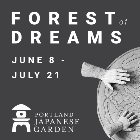 |
 |
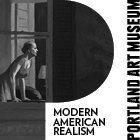 |
 |
 |
 |
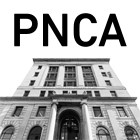 |
 |
 |
 |
 |
 |
 |
 |
 |
 |

|
Site Design: Jennifer Armbrust | • | Site Development: Philippe Blanc & Katherine Bovee | |


